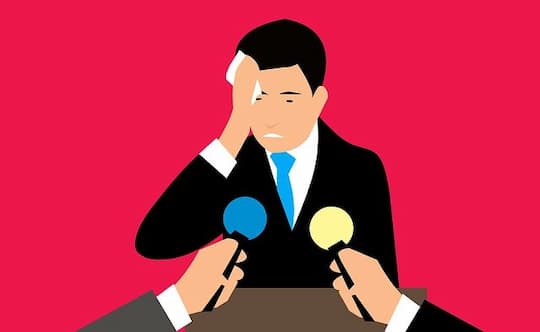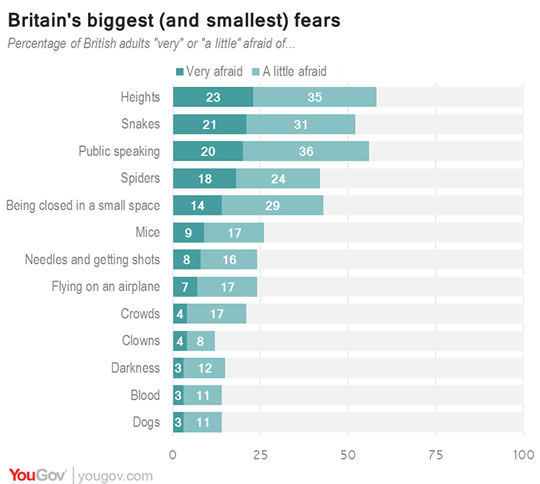Phobias are irrational fears that induce an intense emotion when a certain situation or object is encountered.
A phobia is an irrational fear of something that is unlikely to be dangerous.
People with phobias experience an intense fear when they encounter a certain situation or object.
Naturally, people with phobias do their best to avoid situations in which they might come into contact with the object of their phobia.
Some of the most common phobias are of heights, public speaking and snakes (see below for a long list of phobias).
Phobias are a type of anxiety disorder, which are extremely common, affecting almost one-third of people at some point in their lives.
Types of phobias
The Diagnostic and Statistical Manual of Mental Disorders puts phobias into three broad categories:
- Agoraphobia: A generalised fear of leaving a safe, comforting place, such as home, while fearing contamination, embarrassment or other trauma while out of doors.
- Social phobia: fearing the judgment of others in social situations.
- Specific phobias: fear of a specific situation or object that results in anxiety and can lead to a panic attack.
Psychiatrists and psychologists typically put specific phobias in to these general categories:
- fears related to animals (dogs, spiders, insects)
- fears related to the natural environment (darkness, heights, thunder)
- fears related to blood, injury, or medical issues (broken bones, injections, falls)
- fears related to specific situations (driving, flying, riding an elevator)
- other (drowning, choking, loud noises)
The most common phobias
Heights, snakes and public speaking top the list of things of which people are most afraid.
That is according to a survey of 2,088 British people who were given a list of 13 phobias and asked how fear-inducing each one is (YouGov, 2014).
It was women who were more afraid of each item on the list than men — or perhaps men just won’t admit to their fears.
The widest gender gap was seen for spiders, which scared 52 percent of women but only 33 percent of men (or so they said).
Here is the full list of phobias and the percentage of people that said they were “very” or “a little” afraid of them:
Age also played a role in what people were afraid of.
Younger people were more petrified of public speaking than older people:
- 59% of those between 18-24 said they were afraid of public speaking.
- 32% of people over 60 said they were afraid of public speaking.
Older people meanwhile, were more afraid of heights and snakes.
Unsurprisingly there’s no place on the list for one of the most common fears which most people have never heard of: the fear of holes.
Technically it’s called trypophobia and, according to a recent study, it may result from the visual features of certain poisonous creatures (Cole & Wilkins, 2013).
The study found that around 1 in 7 had some trypophobic reactions.
Like all the fears on the list, arachnophobia, the fear of spiders, varies a lot between people, with some just being ‘scared’ of spiders to others being so terrified they can’t even look at a picture of one.
Of course people in this survey could only respond to the thirteen phobias they were asked about, they might have had other ones.
Here are a few personal favourites:
- Nomophobia: fear of being out of phone contact (no–mobile-phobia: it’s bad Latin, but easy to spell compared with the others…)
- Omphalophobia: fear of bellybuttons; of having one’s own bellybutton touched or pulled or seeing another person’s bellybutton.
- Lipophobia: fear of fat in foods.
- Oikophobia: fear of the home and/or household appliances.
- Hexakosioihexekontahexaphobia: fear of the number 666.
- Sesquipedalophobia: fear of long words (oh, the tremendous weight of irony).
- Panphobia: fear of everything (Woody Allen has this).
The most common phobia you’ve never heard of is…
…the fear of holes.
Technically it’s called trypophobia and, according to a study, it may result from the visual features of certain poisonous creatures (Cole & Wilkins, 2013).
The study found that around 1 in 7 had some trypophobic reactions.
The lead author Dr Geoff Cole explained:
“We think that everyone has trypophobic tendencies even though they may not be aware of it.
We found that people who don’t have the phobia still rate trypophobic images as less comfortable to look at than other images.
It backs up the theory that we are set-up to be fearful of things which hurt us in our evolutionary past.
We have an innate predisposition to be wary of things that can harm us.”
Should your fear of holes be getting the better of you, then use a classic psychological technique: desensitisation.
That means looking at lots of pictures of holes.
Apparently it worked for Dr Cole.
Longer list of phobias (A-Z)
A
- Achluophobia – Fear of darkness
- Acrophobia – Fear of heights
- Aerophobia – Fear of flying
- Agoraphobia – Fear of open spaces or crowds
- Aichmophobia – Fear of needles or pointed objects
- Amaxophobia – Fear of riding in a car
- Androphobia – Fear of men
- Anthrophobia – Fear of flowers
- Anthropophobia – Fear of people or society
- Aphenphosmphobia – Fear of being touched
- Arachibutyrophobia – Fear of peanut butter
- Arachnophobia – Fear of spiders
- Astraphobia – Fear of thunder and lightning
- Autophobia – Fear of being alone
B
- Bacteriophobia – Fear of bacteria
- Bathmophobia – Fear of stairs or steep slopes
- Bibliophobia – Fear of books
- Botanophobia – Fear of plants
C
- Chionophobia – Fear of snow
- Chronophobia – Fear of Time
- Claustrophobia – Fear of confined spaces
- Coulrophobia – Fear of clowns
- Cyberphobia – Fear of computers
- Cynophobia – Fear of dogs
D
- Dendrophobia – Fear of trees
- Dentophobia – Fear of dentists
E
- Elurophobia – Fear of cats
- Entomophobia – Fear of insects
- Equinophobia – Fear of horses
G
- Gamophobia – Fear of marriage
- Genuphobia – Fear of knees
- Glossophobia – Fear of speaking in public
H
- Haphephobia – Fear of touch
- Hemophobia – Fear of blood
- Hypochondria – Fear of illness
I
- Iatrophobia – Fear of doctors
K
- Koumpounophobia – Fear of buttons
L
- Lockiophobia – Fear of childbirth
M
- Mageirocophobia – Fear of cooking
- Microphobia – Fear of small things
- Mysophobia – Fear of dirt and germs
N
- Necrophobia – Fear of death or dead things
- Noctiphobia – Fear of the night
- Nyctophobia – Fear of the dark
O
- Octophobia – Fear of the figure 8
- Ophidiophobia – Fear of snakes
- Ornithophobia – Fear of birds
P
- Pathophobia – Fear of disease
- Pedophobia – Fear of children
- Philematophobia – Fear of Kissing
- Philophobia – Fear of love
- Phobophobia – Fear of phobias
- Pteromerhanophobia – Fear of flying
- Pyrophobia – Fear of fire
S
- Scolionophobia – Fear of school
- Sociophobia – Fear of social evaluation
- Somniphobia – Fear of sleep
T
- Technophobia – Fear of technology
- Trypanophobia – Fear of needles/injections
- Trypophobia – Fear of Holes
V-Z
- Verminophobia – Fear of germs
- Wiccaphobia – Fear of witches and witchcraft
- Xenophobia – Fear of strangers or foreigners
- Zoophobia – Fear of animals
.


